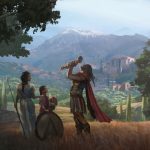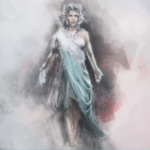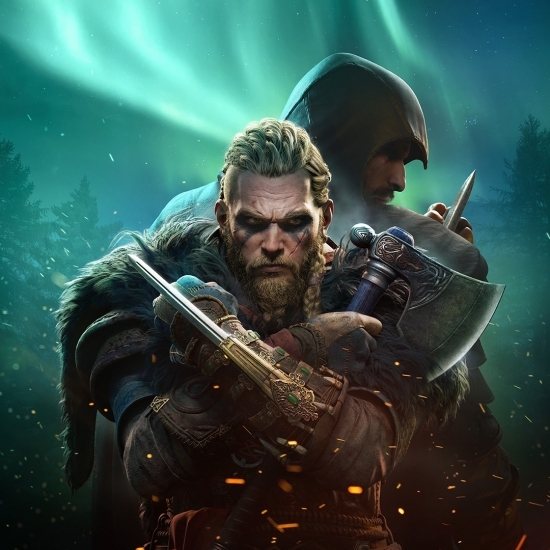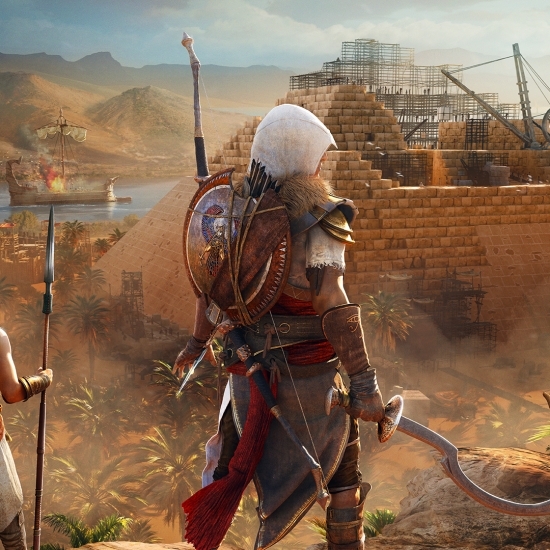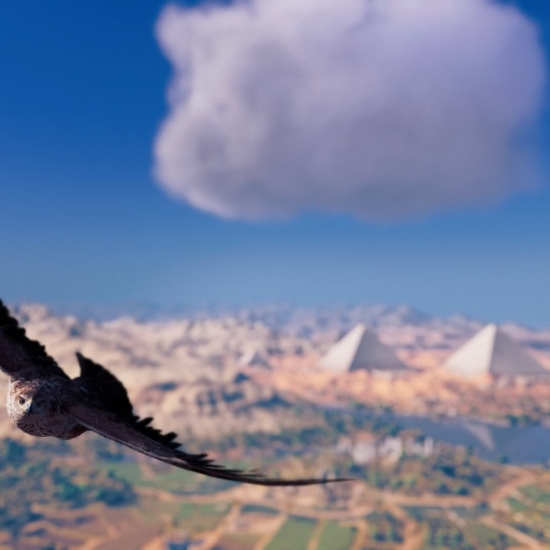INTRODUCTION
After its predecessor served as a total revamp for the franchise, altering countless gameplay and visual aspects, Assassin’s Creed Odyssey comes more additions, introducing dialogue options that will alter the path of the story including the ending, as well as a choice between two protagonists, Alexios and Kassandra, a first time in the franchise’s history, the later approached differently from Syndicate and Origins, as Odyssey allows players to experience the whole game as either one character or the other, walking the exact same path.
These elements were added to a similar play style to that of Origins, further emphasizing on Assassin’s Creed becoming more of an RPG experience. However, for the first time in the franchise’s history, the hidden blade, a signature weapon of the Assassins in every other installment is completely dropped and replaced by the broken Spear of Leonidas, a First Civilization artifact that can serve both as a regular weapon and one with “magical” capabilities, which allows players to experience a fantasy-like combat in certain instances, without breaking the franchise lore, by explaining the magical effects as technology of the First Civilization.
In this review, I will be exploring the various aspects of Assassin’s Creed Odyssey; story, gameplay, visuals, world and music, while refraining as much as possible from major spoilers.
STORY
Set in 431 BCE in Greece against the backdrop of the Peloponnesian War between Sparta and Athens, players will take control of either Alexios or Kassandra, both from a Spartan family and descendants of King Leonidas. The protagonist’s family has been harassed by the Cult of Kosmos, eventually the protagonist leaves the family after surviving a major fall and growing up far away from Sparta, in Kephallonia where the game story begins and experiencing flashbacks of their childhood. From there our journey begins…
The overall story unfold throughout three major arcs; the family arc, the First Civilization arc and the present day arc. The first arc which players will be introduced to is the family arc with the other two coming into play at different stages of the game, and while the game is majorly focused on the family arc, the stories of Layla Hassan in the present, King Leonidas in 480 BCE and the First Civilization arc all serve as anchors and reminders of the greater picture and the protagonist’s place in the over-arching narrative and their impact on history.
When it comes to telling a story about the Assassins and Templars -both factions adopted their famous titles from the real life factions “Al Hashashin (The Assassins)” and “The Knights Templar” but have existed for millennia, roughly since 75,000 BCE- Odyssey serves as an outsider’s perspective, mainly focusing on The Cult of Kosmos, a cult of masked figures that operates from behind the scenes, manipulating both sides of war and taking advantage of the ensuing chaos to establish the foundations of their own new world, while the Assassin’s Creed takes the backseat, for now.
The family arc is the one most affected by players’ decisions including its ending, while the other arcs are mainly scripted to preserve the canon of the over-arching narrative, which is a smart move to allow dialogue options in a somewhat self-contained manner, despite a specific moment where your choice will manifest itself onto the other arcs.
Longtime enthusiasts of the over-arching narrative will rejoice as Odyssey puts more emphasis on the First Civilization and present day than Origins did, and the game does apparently set up for the upcoming post launch content, which promise a deeper exploration of the secrets of the First Civilization city of Atlantis as well as the story of the original wielder of the first hidden blade.
In addition, Odyssey brings back playable modern day with more diversity in settings, though without the ability to freely leave the Animus, yet there’s definitely much more for Layla to see and do than she had in Origins within the cave where she set up her Animus for the entire game. She uses both her own portable Animus along with an upgraded version of the Brahman VR-like device, depending on where she’s set up. Files on Layla’s computer give more insight into the events going on in transmedia, along with some characters from the comics joining Layla by some mean or another in the game.
Overall, the plot of Odyssey is one of the richest. There are certain gaps and parts that feel rushed, such as Layla’s knowledge of the First Civilization, which wasn’t reflected upon in Origins or some time and place jumps and skips that would’ve been better if they were shown with more detail in cutscenes, rather than abruptly cutting to the chase and letting players only imagine what happened in between. There’s clearly much more effort implemented in the present day storyline than there was in Origins, and it’s a good step forward, but it could still use more work to fully actualize itself as a distinctive and well-constructed aspect of the game.
Regarding the adherence to the lore and the the rationalization of fantasy elements (such as boss battles with Medusa) and legendary animals, the game does present a lore-based explanation other than the infamous “It’s an Animus glitch” or “It’s an illusion/dream”, which is a nice touch. As for the choice of protagonist, this does remain a questionable aspect. The intro of the game does try to explain that, though another point pretty much solidifies the fact that the game is your own odyssey, so whatever you choose is the right choice within your own odyssey, independent of other players’ choices. It’s a bit of a hard pill to swallow in a franchise long dependent on a cohesive lore, but the game does make up for that with some surprises and improvements.
CHARACTERS
The beauty of the storyline lies in the characters. Both Alexios and Kassandra, despite the fact that their decisions shape their personality depending player choices, are established characters, as well. The actors behind them have done a great job breathing life into them. They’re different from the other protagonists we’ve come to know throughout the franchise since they’re not allied with any faction. They’re not Spartan nor Athenian warriors, but mercenaries often feared by their society or looked up to when requesting a favor. So they’re more like heroes, which sets them apart from the other ordinary members of their society and their laws, prejudices and principles.
The side characters and villains are among the most memorable in the franchise. Their conversations, relationships and impact on one another are complex making them quite memorable. Barnabas and Herodotus accompany Alexios/Kassandra on their journey, providing them with advice, documenting their journey while Sokrates has some interesting philosophical and political debates, sometimes with the purpose of convincing an audience with a certain idea that has to do with their allegiance with a specific political figure.
WORLD/ EXPLORATION
One of the highlights of the game is its own world, as Odyssey presents the largest world yet, with the most diversity and atmosphere. As a whole, the world is much larger than that of Origins. Water is about %40 of the map, but the landmasses are large and most of them are well-populated, rich in temples, tombs and massive monuments. The architecture varies from bright white marble to brown, to wooden structures, and buildings reflect different eras and civilizations that inhabited Greece, including the ancient Minoan civilization. Many of the structures share common features in terms of architecture, but a good variety in colors, and nature. Some areas feature dense forests, other are dominated with populated areas, walled cities and forts, while others are volcanic, devoid of life and rich in lava, smoke and steam. Arid locations dominate the southern landmass, snow covers some mountain tops creating a beautiful contrast with the lush cities near the foot of the mountain.
From a first glance in the early stages of the game, the world of Assassin’s Creed Odyssey may seem quite similar to that of Origins. However, as you progress and explore other areas, the vibrance and the diversity in scenery, geography, architecture and vegetations become quite clear. Day and night cycle and weather changes affect the world in a significant and beautiful way. During the day, the beauty of the water, the trees, the buildings, the people and their clothing shines with the sunlight while during the night, lanterns, candles and torches illuminate the populated areas, with a beautifully detailed sky full of stars and a bright moon creating a wondrous view from mountain tops and aboard the Adrestia. The sky itself is so alive and vibrant that it changes the atmosphere drastically especially during sailing.
Weather changes are another beauty of this detailed world of ancient Greece. When it rains, the soil, the trees and the buildings look realistically wet, adding another shade of variety to the world. Sometimes it rains lightly, and it occurs during a partly cloudy sky while other times, a thunderstorm with heavy rain takes place, creating a breathtaking view.
In addition to the beauty and diversity of the world, there’s also life within it, characters who have a life and chores to carry on. In one of my tours around the world, I saw a soldier trying to help another who was lying on the ground, and it happened once so randomly in a road that I rode through multiple times, showing how there are living NPCs within the world whom you could stumble upon at any point of their lives.
It’s hard to pick a favorite city or landmass in Odyssey because the world is full of wonders and the various locations are both distinct and also seamlessly connected, making for a beautiful and a natural transition.
VISUAL FIDELITY
In terms of graphical prowess and aesthetics Odyssey is quite similar to Origins. The scale of the world is among the most powerful aspects of it. When traversing the world and you’re on the side of a mountain attempting to reach a specific point on the other side of the valley, not only does the height feel genuinely high, but the distance also feels massive. You can truly feel that this other point is realistically far away from you, and that’s not to say that the world is big for nothing, on the contrary, there’s a lot in between, whether it’s a wide range of trees and plants, a viewpoint to sync, people doing about their daily chores, characters to give you side quests, soldiers walking from one point to another or bandits that might pick a fight with you.
The protagonists along with the side characters and villains are made with careful detail from facial structure to hair to their outfits and gadgets. The water, especially during sailing, is one of the best I’ve ever seen, with its sense of realism, the animation of the waves, the foam it creates during waves and near the shores, the way the ship is lifted by the motion the water which can even assist in a more powerful ram with the power of the waves during combat.
The color palette varies from one region to another. Some trees are yellow to orange brown, others are light green, dark green or with more shades of pink/red, while other trees are burnt and barren of any leaves. Visual effects and animations add an extra layer of beauty and uniqueness to the world, for example some forests show beautiful animations of falling leaves of autumn, while the vault where Medusa is found is surrounded by an otherworldly barren forests showing floating ashes and amber particles coming out of cracks in the trees like lava and rising upwards. These effects and the overall visual fidelity of the game, create a beautiful sense of diversity and uniqueness to each location that help making exploration a joy in and of itself.
GAMEPLAY
Infused with RPG elements and magic-like abilities, the gameplay is an evolution of what Assassin’s Creed Origins offered. A very similar quest and combat system is implemented with the addition of the powerful special attacks with the broken Spear of Leonidas (a First Civilization artifact with high-tech capabilities). The Spear is upgradable throughout the experience through six levels in total. As you slay members of the Cult of Kosmos, each of them grants the protagonist a “Shard”. Those are used to upgrade the Spear in an “Ancient Forge”, a First Civilization site dedicated to weapon development.
Odyssey follows a quest-based system like Origins where players can accept a multitude of quests and completes them whenever they please. There are Odyssey quests (story-driven ones related to the family, First Civilization, present day and Cult of Kosmos arcs) as well as character quests which are side quests related to specific characters that task you to perform, world quests that are related to various activities around the world, not linked to a specific character or plotline, in addition to contracts and bounties, some of which are time-limited tasks that players can find on message boards. All those contribute to raising the player’s level through XP, items and money.
Exploring new regions, completing specific locations with objectives like killing the fort’s Captain, Polemarch and/or cultist guards or finding an ancient tablet, Ainigmata Ostraka and/or treasure chests, grant players XP, drachmae (money) and/or items. As you gain more XP, your level increases and you become more capable of tackling more difficult bosses. Each region of the world has a specific level range, referring to the difficulty of the tasks and enemies there. As you progress and level up, lower level cities and enemies will also rise in levels, but not in a way that surpasses the player, but rather lower, but closer enough to the player that they still pose a little challenge. For example, let’s say Kephallonia’s level range is 5-10, with its quests ranging in between, after the player reaches level 40, the city will have risen in level to say 25-30, with the tasks that player took and did not finish reaching a similar level. They will be much easier to finish than higher level tasks, but still they won’t remain level 5 or 8…etc. which ensures that the game won’t get incredibly easy if you level up, even though lower level enemies will be noticeably easier than others to tackle, even droves at once.
One of the unique aspects of the gameplay is that it’s built around the protagonist being a mercenary along with the occurrence of the Peloponnesian Wars. Alexios/Kassandra will carry out tasks for money as mercenaries, along with fighting mercenaries tasked by their enemies to hunt them. The protagonist has a choice either to engage in combat with them, pacify and recruit them to your ship or to pay the bounty. The protagonists themselves are ranked among other mercenaries and can rise through the ranks depending on how many mercenaries they can defeat. In addition to that, due to the game being set during the Peloponnesian Wars, members of either side, the Athenians and the Spartans are engaging in combat by different means. Due to the fact that the protagonist is a mercenary and the Cultist have infiltrated and manipulate either sides of the war, it’s up to the player to decide whether to fight for Athens or Sparta and in which city. Players can choose to infiltrate Spartan or Athenian forts and steal their national treasure, destroy their equipments and defeating their leaders and eventually initiating a conquest battle (the former actions drastically affect the difficulty of conquest battles) in which the winning side will take control of the city. The game will notify the player of the progress of the war and which side is in control of which city as well as the strength of their domination over that city, which changes from time to time throughout the experience.
What makes Odyssey so entertaining isn’t only that it’s built with four difficulty levels in addition to the Exploration and Guided modes and fully adjustable HUD (which drastically enhance the difficulty for players) but also the leveling system. You can adjust your own difficulty by choosing to tackle harder enemies without leveling up high enough to reach them. Just because an enemy is 5 or 8 levels above you, doesn’t mean that they’re impossible for you to tackle. There are numbers aspects that aid in completing a quest and numerous ways to do so. You can use your skill to your advantage, fighting an enemy who can kill you with one or two blows due to their high level, without letting them touch you or by shooting arrows at the from a spot where they cannot reach, or constantly varying between dodges and attacks or even changing the time of day, allowing the character to sleep and other guards to move to a different spot, giving you a window to reach them undetected and either killing them instantly or taking a large option of their health bar with a stealth attack, all of which make completing a mission of a much higher level to be quite possible.
In addition to that, you can use the world with its nature and inhabitants (human and none human) to your own advantage. In one of the fights I had, I faced five cultist guards at once, who were five levels above me and the fight took place near a cliff, I was varying between attack them and climbing down the cliff, hiding between the rocks where their spears, arrows and swords couldn’t touch me, and at one point, as one guard attempted to climb down to find me, with his full health bar, he fell to his death from the cliff giving me one less enemy to worry about. Another example is a quest where I had to slay an alpha animal to retrieve an item from a character that he attacked and devoured before. The lion had a much higher level than me and I was literally no match for it, so I was preparing to attack from a pillar nearby, but he was about to spot me so I hid away and kept watching it move forward until the lion encountered and attack an army (of a much higher level than me) passing by, they kept fighting each other until the army managed to kill the lion. Once they army moved forward, I came to collect the item from the lion’s corps without a sweat, and a similar example occurred with a huntress and her bear, where I let the protagonist meditate until nightfall, and as they decided to explore, I followed them until they were attacked by other enemies and were both defeated, allowing me to claim my reward without any physical effort.
Of course, all of that depends on the circumstances of the area you’re about to invade, the number of targets you need to reach and how many enemies are attacking you at the same time. Conquest battles might be quite harder or even impossible to tackle if they were of a much higher level than the protagonist, as you’re faced with droves of enemies, and it becomes quite tricky to vary between attacking, dodging, healing and performing powerful attacks, as all those consume adrenaline bars, which you can refill with attacks and increase with further upgrades and leveling up.
In terms of customizations and weaponry, outfits aren’t given in full but as pieces that you gain from either the same or different quests or hidden underwater, within chests or from the targets you slay. Weapons are available in different classes; swords, heavy-bladed, heavy blunt, staves, daggers and spears, which you can acquire from similar sources as the outfits, or purchase from blacksmiths (who have different stock from time to time and from each merchant to another). Normally, slaying a high level target will offer a high level weapon. Low level weapons can still be upgraded through blacksmiths with leather, iron, wood and drachmae. Those resources can be found all around the world, as well as gained from dismantling existing gadgets. Players can dismantle or sell all types of gear except for Legendary Gear, which can neither be sold nor dismantled.
The Cult of Kosmos, the main villainous faction in the game, is approached in a similar way to The Order of the Ancients in Origins, but there’s a much larger number of Cultists both men and women of various professions and classes. Some are upper classes members and political figures, others are arena fighters, slave traders, farm owners, command ships and even leaders of certain locations (and different levels and classes/branches within their own faction). The game tackles them in an intelligent way, making some members directly related to main quests, that are required to complete the family arcs, while others are seemingly more like a side quest but contribute to the ability to reach the true ending of the game, similarly to how finding Codex pages is treated in Assassin’s Creed II, in addition to the fact that they’re the main and only way to upgrade the broken Spear of Leonidas to its maximum potential.
Members of the Cult of Kosmos aren’t directly named and identified as their identities are obscure. They could be someone the player knows about or have met before, therefore, in order to uncover their identity to fight them, players will need to investigate, which is a nice throwback to how Altair used to investigate before assassinating his targets in the first Assassin’s Creed, albeit with different methods. You no longer tail nor eavesdrop, but you can find clues about cult members from certain sources, the game often minority hints where to look for the next clue whether in a mine in a specific city, a leader of a certain location that you can acquire it from after assassinating him/her in a conquest battle, an underwater location or assassinating another Cult member, which makes hunting Cultists an enjoyable task that will encourage players to explore and to finish other quests.
Arena fights return in a similar manner as Origins, albeit being more restrictive in terms of environment size and the number of targets to face. The Arena is a fun way to test out your fighting skills and to boots your XP, especially when you’re skilled and well-leveled up to stand a chance against waves of enemies and major bosses, along with some mercenaries.
Sailing is the main way to reach other landmasses separated by water from others. Players can use small boats for short distances (because they will break and sink if used in the high seas) and the Adrestia is the main way to travel throughout the waters and to combat other ships. The Adrestia is your home away from home, fully customizable in a similar way to Black Flag, allowing players to use resources and money to upgrade the hull, the ramming and rowing capabilities, archers, javelins and fire arrows..etc. as you progress, in addition to allowing players to select up to four lieutenants to sail with you as well as a set crew of men or women aid you as you sail, engage in naval combat and board other ships, as well as singing their beautiful shanties.
MUSIC / SOUND DESIGN
A vast world like that of ancient Greece in Assassin’s Creed Odyssey requires great tunes that match the beauty and diversity of the world. Assassin’s Creed Odyssey delivers just that. The soundtracks reflect the era in a brilliant way, the sea shanties sung both in male and female vocalists deliver one of the most beautiful moments of the game, the welcome return of ambient music during exploration which varies from one style to another, and the play out in specific moments that I couldn’t help but find myself focusing more on the music than the dialogue or the game.
Beside the music, sounds of waves clashing, diving underwater, the wind, thunderstorms, the rain, the people, it all adds another layers of life to this massive world, you can almost feel like you’re breathing the same air, smelling the world as the characters do.
FINAL WORD
Coming with a plethora of changes to the brand’s style and genre, Assassin’s Creed Odyssey grows from the brand new formula of Assassin’s Creed Origins and takes off with its new set of features, establishing itself as an RPG open world experience. It is great departure from what Assassin’s Creed once was in terms of play-style, mission design, story-telling and even the terminology of in-game elements, but does its’ best to preserve the essence of the franchise. Not only the gameplay design and structure, but the era might too have had an impact on what’s possible to tell about the Creed and the Order in an era that predates the two factions in their known iconic forms and aesthetic.
Introducing dialogue options and character selection was a questionable choice to numerous fans who have known for far too long that the Animus itself relies on synchronizing genetic memory exactly the way it happened (with minor deviations such as the method of assassination, being detected or not or finishing certain optional requirements), which is now giving boundless freedom to players, countless customizations and the total absence of social stealth, in addition to introducing romance options, a nice touch that was promoted during the game’s announcement, though it ended up being more of an easily missable optional feature, without much depth or commitment like Mass Effect 2 and 3 or The Witcher 3: Wild Hunt.
Odyssey shifted the focus to telling your own story, being accompanied by a historian who documents your adventure, following three narrative arcs that aim to satisfy different types of fans of the brand. It brings the long-awaited focus on the lore back, something the franchise has been missing for a while and help establish Layla Hassan as a modern day protagonist with a brand new arc, even though it is still not very clear what exactly the new threat for humanity is, where Layla stands in all of it or the meaning behind the cryptic transmissions of the First Civilization and another missed opportunity to utilize Greek mythological figures in a meaningful way within the context of the lore, but with the intertwining story arcs along with the interesting new characters, artifacts and elements that we’re introduced to, create an expansive experience that show promise of various possibilities for the future of the franchise, making Odyssey one of the most memorable Assassin’s Creed games in recent memory.
Assassin’s Creed Odyssey releases tomorrow for early access and October 5th, globally on PlayStation 4, Xbox One and PC.
SCORE – 9.3/10
-
 RINO THE BOUNCERPharmacist. Visual Artist. Ubisoft Star Player, Assassin's Creed Brand Ambassador, Founder and Community Leader of The Codex. Tomb Raider Localization Ambassador and Official Fansite Founder.NEWS FEEDTestimonial"Just stumbled across this site after looking at some topics on the Ubisoft Forums, this is great! Exactly the thing I was looking for.""Your site lays everything down in an interesting and easy to read format, even I learn new things whilst reading your articles!""This needs more than just 5 stars!""There is only one word AMAZING!!!!!!! GREAT WORK.""Very in depth and very well thought out! Keep up the good work!"One of the best (if not the best one) AC community pages out there. Keep up the good work!
RINO THE BOUNCERPharmacist. Visual Artist. Ubisoft Star Player, Assassin's Creed Brand Ambassador, Founder and Community Leader of The Codex. Tomb Raider Localization Ambassador and Official Fansite Founder.NEWS FEEDTestimonial"Just stumbled across this site after looking at some topics on the Ubisoft Forums, this is great! Exactly the thing I was looking for.""Your site lays everything down in an interesting and easy to read format, even I learn new things whilst reading your articles!""This needs more than just 5 stars!""There is only one word AMAZING!!!!!!! GREAT WORK.""Very in depth and very well thought out! Keep up the good work!"One of the best (if not the best one) AC community pages out there. Keep up the good work!
